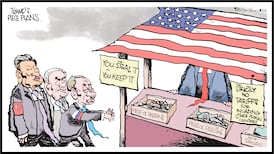Elections are the moment for political parties to present their ambitions for the nation and for citizens to set the course.
Citizens are best placed to make good choices when campaign promises are transparent and realistic. In some countries independent evaluations of economic plans underlying the election platforms help ensure this. Interest in this type of analysis is on the rise internationally, in line with the growth of independent fiscal institutes.
There is no one size fits all approach to costing election manifestos, as international experience shows.
In Australia, parties are legally required to undertake a costing of their plans with the results being presented only after the election. In the UK, the Institute for Fiscal Studies basically tries to establish on the basis of the public statements of parties, whether the various budgetary statements made by parties add up.
However, such an exercise should not be undertaken lightly; it needs to fit with local circumstances. Whether Ireland should take this up or not is not for us to say.
In this article, we share our 30 years experience in this area in the Netherlands. We, CPB Netherlands Bureau for Economic Policy Analysis (CPB), an independent economic research institute, have been requested since 1986 by many political parties to assess the fiscal and economic effects of their election platforms. Over the years, the scope of the assessment has varied, but the core of the analysis focuses on the direct fiscal cost of the programme, its macroeconomic and income effects in the next parliamentary term and long-run effects on labour supply and the sustainability of public finance. The number of participating political parties has gradually increased from three in 1986 up to 10 in the last election (2012).
The assessment consists of several steps. First, a macroeconomic baseline for the next parliamentary term is constructed assuming no policy change. This baseline is the benchmark against which all policy effects are calculated. Second, political parties provide further and very detailed information on the design of concrete policy measures they envisage (on average about 250 per party).
Policy measures
The basic assumption is that the party possesses a majority in parliament and is thus able to push things through. Policy measures that require constitutional reform, policy measures which cannot be taken unilaterally by the Dutch government (eg European policies) and measures that are not practically or legally enforceable (eg halving the civil service overnight) are not taken into account.
CPB then assesses the direct fiscal revenue or costs of individual policy measures, drawing on expertise of the ministries if necessary, and reports back to the parties. In this phase there is intensive contact between CPB and the political parties. In the next step, the short and long-run effects of the policy packages on the economy, incomes, and public finance are calculated with a set of specific models. These outcomes are published simultaneously after a final check with the parties involved. Obviously, an exercise of this magnitude is time-consuming (approximately 3½ months) and labour-intensive.
There is always a lot of discussion about the pros and cons of the assessment. A first criticism is that it frames the political debate. The assessment is an economic assessment and elections cover a broader range of topics, from foreign policy to justice. More specifically, parties wish to do well in the assessment and are thus tempted to focus on measures that reap the desired quantitative results and avoid those that score badly on the indicators presented (“gaming”).
Measures are excluded, when they are not practically feasible or legally enforceable; novel ideas that have never been assessed and deliver highly uncertain savings may be excluded as well. This may lead to a bias against new, creative policies. There are also advantages. The evaluation puts a discipline on the debate prior to the election because it provides a reality check on the promises and ambitions of the parties. The outcomes of the evaluation will show when the figures do not add up.
A second advantage is that the discussion with CPB helps political parties to underpin their programme with concrete policy measures. This improves their knowledge of costs, benefits and effects of policy measures. Furthermore, it greatly facilitates negotiations between coalition partners after the elections, because the costing of the policy measures in their manifestos is already available.
Costing exercise
A successful introduction of a full-fledged costing exercise depends on the willingness of (some) political parties to flesh out their policy plans. Next, it requires an institution or set of institutions that is generally viewed as non-partisan to make the assessment.
This institution should possess the necessary institutional knowledge of tax and social-security systems, experience and the manpower in order to be able to perform the analysis in a relatively short period prior to elections.
Moreover, a good working relationship and the flow of information with the ministries are paramount. Alternatively, one could start off with a more limited exercise with only direct costing of the most important fiscal policy measures. This would still require parties to be transparent in their policies and have a preventive effect. A modest good start might present the best stepping stone to more ambitious enterprises later on.
In the end, any costing exercise will only deliver a true reality check, if it connects with the couleur locale. It will be interesting to see how the Irish will fare on this issue.
Laura van Geest is director general CPB Netherlands Bureau for Economic Policy Analysis. Johannes Hers is head of public finance









